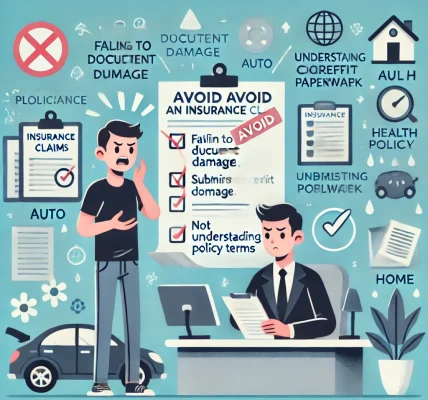Introduction
Business insurance is a crucial safety net that helps protect companies from financial losses due to unexpected events such as property damage, liability claims, and business interruptions. However, filing an insurance claim can be complex, and without proper knowledge, businesses may face claim denials or delays. Understanding how to handle business insurance claims effectively can ensure that your company receives the compensation it deserves.
This guide will walk you through the key aspects of business insurance claims, including common claim types, the claims process, tips for avoiding denials, and how to maximize your payout.
Common Types of Business Insurance Claims
Businesses can face various risks that require different types of insurance coverage. Here are some of the most common business insurance claims:
- Property Damage Claims
- Covers damages caused by fires, floods, storms, vandalism, or theft.
- Essential for protecting physical assets like buildings, equipment, and inventory.
- Business Interruption Claims
- Provides financial compensation for lost revenue due to disasters or forced closures.
- Helps cover fixed expenses such as rent, payroll, and utilities.
- Liability Claims
- Covers legal fees and settlements in case of lawsuits related to bodily injury, property damage, or advertising claims.
- Includes general liability, professional liability, and product liability insurance.
- Workers’ Compensation Claims
- Provides medical coverage and lost wages for employees injured on the job.
- Required in most states for businesses with employees.
- Cyber Insurance Claims
- Covers financial losses due to data breaches, cyberattacks, and other digital threats.
- Essential for businesses handling sensitive customer data.
- Employment Practices Liability Claims
- Protects against claims related to wrongful termination, harassment, or discrimination.
- Helps businesses cover legal defense costs and settlements.
Step-by-Step Guide to Filing a Business Insurance Claim
1. Review Your Policy Coverage
- Before filing a claim, carefully review your insurance policy to understand what is covered and any exclusions that apply.
- Check the policy limits, deductibles, and reporting requirements to avoid surprises.
2. Document the Damage or Incident
- Take clear photos and videos of the damage or incident.
- Keep detailed records of losses, including receipts, invoices, and financial statements.
- Obtain witness statements if applicable.
3. Notify Your Insurance Provider
- Contact your insurer as soon as possible to report the claim.
- Provide all necessary information and documentation required for the claim process.
- Keep a record of all communications with the insurance company.
4. Work with an Insurance Adjuster
- An insurance adjuster will assess the damage and determine the claim amount.
- Be prepared to provide additional documentation and answer any questions.
- If you disagree with the adjuster’s assessment, you can hire an independent adjuster for a second opinion.
5. Negotiate and Follow Up
- Review the settlement offer carefully and negotiate if necessary.
- If the offer is lower than expected, provide additional evidence to support your claim.
- Follow up with the insurer regularly to avoid unnecessary delays.
6. Receive Compensation
- Once the claim is approved, your insurer will provide the agreed-upon payout.
- Ensure the funds are used appropriately to recover from losses and resume business operations.
Tips to Avoid Claim Denials and Delays
- Understand Your Policy – Read your insurance policy carefully and ensure you have adequate coverage for potential risks.
- Keep Accurate Records – Maintain detailed records of all assets, transactions, and incidents that could lead to a claim.
- File Claims Promptly – Report incidents as soon as possible to avoid exceeding the filing deadline.
- Provide Complete Documentation – Incomplete claims can lead to delays or denials.
- Work with an Insurance Professional – Consider hiring a broker or attorney to assist with complex claims.
What to Do If Your Business Insurance Claim Is Denied
If your insurance claim is denied, don’t panic. Follow these steps to dispute the decision:
- Review the Denial Letter – Understand the specific reason why your claim was rejected.
- Gather Additional Evidence – Collect more documentation to support your claim.
- Request a Reassessment – Ask your insurer to reconsider the decision with the new evidence.
- Seek Mediation or Arbitration – Some insurers offer alternative dispute resolution methods.
- File a Complaint – If necessary, report the issue to your state’s insurance regulator.
- Consult an Attorney – If all else fails, legal action may be required to recover your losses.
Conclusion
Business insurance is a vital tool for protecting your company’s financial stability. However, successfully filing and receiving an insurance claim requires careful documentation, prompt action, and a strong understanding of your policy. By following the right steps and avoiding common pitfalls, you can ensure your business gets the coverage it deserves when it matters most.
If your claim is denied, don’t give up—explore your options for dispute resolution and legal assistance. By staying informed and proactive, you can safeguard your business’s future against unforeseen risks.
Woulike an image to accompany this article? Let me know, and I can generate a relevant illustration for you!




